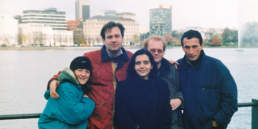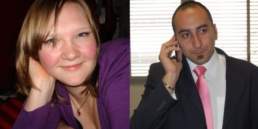20 years ago, in April 1992, the Bosnia and Herzegovina war started. In more than three years, until autumn 1995, countless people were killed, horrible atrocities were committed, mounting up to the massacres of Srebrenica. AEGEE tried to help the students in Bosnia. This is the first of two articles that give an impression what we did. AEGEE’s Balkan expert John Stienen, former AEGEE-Eindhoven member, wrote a paper about the development of AEGEE in former Yugoslavia in the 90ies. Below you will find the text passages about AEGEE in Bosnia and Herzegovina.
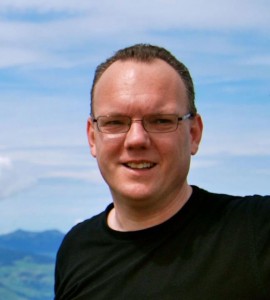
A referendum on independence organised in Bosnia and Herzegovina in 1992, was the spark that lead to the ignition of full-flared war in this country populated by mainly Croats, Serbs and (Bosnian) Muslims. The fast recognition of the three segregated states by the European Union and the United States could not save Bosnia and Herzegovina from its awful fate.
Especially Sarajevo, an Olympic city, became a worldwide symbol of the insanity of war. Soon after the war in Bosnia and Herzegovina started, the Yugoslav People’s Army (JNA) and local Serb militia surrounded the city and it was literally cut-off from the outside world. Yet student life in Sarajevo continued. A group of French students committed itself to helping the students in the isolated city. They organised themselves into “Etudiants pour Sarajevo” (EpS, Students for Sarajevo).
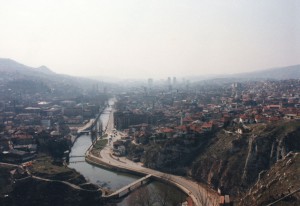
EpS organised various activities, ranging from lectures and slide-shows to inform people about the situation in the besieged city to organising collections and visiting students inside the town. It was at one of the lectures organised in Aachen, January 1994, that AEGEE came into contact with EpS. Contacts were intensified and by the spring 1994 Agora in Munich, AEGEE-Europe decided to become a supporting association of EpS. EpS provided the framework and AEGEE-Europe organised several events.
Soon we discovered that the AEGEE network is not fit for Europe-wide collections. Lacking logistics support, collections of goods or books only proved successful on a local level. AEGEE’s role appeared much bigger in the process of creating awareness amongst young Europeans of a horrible war in their own continent. Among the activities organised to create awareness, the AEGEE-Tilburg conference “Ex Yugoslavia, Causes and Consequences”, organised in co-operation with “Tilburg ZaMir” (October 1994), was the most important one.
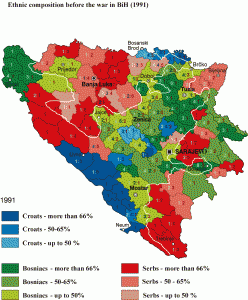
One of the main projects initiated by EpS was a pen pal project. EpS members travelling to Sarajevo would carry letters from and to the city, thus opening a window for the Sarajlije to the outside world. The idea was adopted by AEGEE. Since a young American had started a Bulletin Board computer system in former Yugoslavia connecting the main cities Zagreb, Beograd, Ljubljana, Tuzla, Priština, and Sarajevo at almost the same time as e-mail started to get widely accepted inside AEGEE, it was almost logical to combine the pen-pal idea with the possibilities of communication by e-mail. The AEGEE e-mail pen-pal project was born. Towards the end of 1994 AEGEE’s activities for EpS and the AEGEE committee that had helped to prepare the Strasbourg Conference “Vigilant for Democracy & Freedom”, stood at the cradle of the AEGEE Human Rights Working Group (HRWG).
In the meantime the Amsterdam based NGO “Youth Solidarity with former Yugoslavia” (YSY) had established itself. One of their projects focuses on Tuzla, the second largest university town in Bosnia and Herzegovina. By 1994 YSY had an almost permanent delegation inside the town. The delegation mainly dealt with youth and students in Tuzla. AEGEE-Europe, not wanting to limit itself to helping Sarajevo alone, also established contacts with YSY. These contacts lead to the first AEGEE visit to Bosnia and Herzegovina in summer 1995 by Gunnar Erth and Egens van Iterson Scholten. During the visit the ideas of YSY, AEGEE, and some Bosnian students to found AEGEE in Tuzla were put into practise.
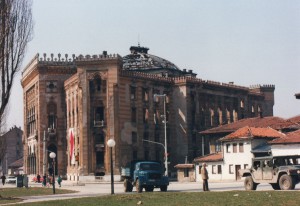
As a result of the e-mail communications project, AEGEE was in contact with students in Sarajevo already before the end of the war. As soon as the war was over and it was safe to travel to Sarajevo, Alex Ootes went to the Bosnian capital in January 1996, followed by Gunnar Erth in March 1996 and shortly after later myself, to develop AEGEE there.
In the mean-time, a few months before the Bosnian war ended and a peace-treaty was signed in Dayton, Ohio, in November 1995, the international community had partly lifted the embargo which was in effect to force rump Yugoslavia to end its involvement in the war in Bosnia and Herzegovina. Attempts to create AEGEE in Beograd had failed until then, because cultural exchange was one of the prohibitions laid down in the embargo. Still in April 1995 students from Novi Sad and Beograd had managed to visit the “European Week Eindhoven” despite the embargo, and during the AEGEE-Eindhoven counter visit to the two towns, preparations were made to found AEGEE there as soon as the embargo would be lifted.
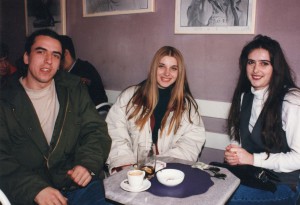
Now the city was open for visitors, YSY actions in Tuzla were extended: AEGEE contributed to a teacher’s project, involving the subjects “English language” and “Computer skills”, which were taught in Tuzla by Zuzana Malejčiková and by several AEGEE members from Delft.
In April 1996 the HRWG and AEGEE-Udine organised the conference “Former Yugoslavia: a better future?” – a conference visited by AEGEE members from Bosnia, Slovenia, Croatia and other European countries. For most of the Bosnians this was the first time to meet Europeans outside their own country. In the autumn of the same year the HRWG was the initiator of the “Case Study Trip to former Yugoslavia” (CST).
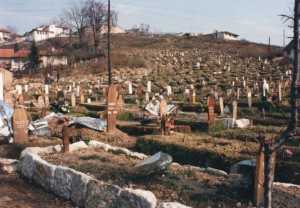
This CST called on Maribor, Zagreb, Sarajevo, Tuzla, Novi Sad, and Skopje in an attempt to create a map of the state of mind of the youth in the countries of former Yugoslavia. The research was conducted by 20 young Europeans, both from the area and from outside. In total 500 people were interviewed, and the results were presented to the AEGEE network, to other European NGOs and to several European institutions.
Shortly after the first CST, AEGEE was confronted with the difficulties that students in post-war Bosnia and Herzegovina face. Most Bosnian AEGEE students being unable to finance trips abroad, combined with the inability of the AEGEE network to financially support its less affluent members, lead to a decline in the membership of our Bosnian locals.
John Stienen
You can download John Stienen’s full report here.
Part 2: Founding AEGEE-Tuzla in the Middle of the Frontlines

